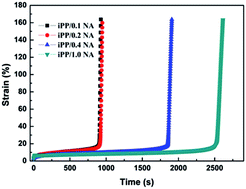Effective enhancement of the creep resistance in isotactic polypropylene by elevated concentrations of DMDBS†
Abstract
Isotactic polypropylene (iPP) specimens nucleated with different contents of alpha-phase nucleating agent (1,3:2,4-di(3,4-dimethylbenzylidene) sorbitol, trade name DMDBS) were employed to investigate deformation-induced microstructure evolution during creep deformation. Morphological investigations using scanning electron microscopy showed that the crystalline morphology of nucleated iPP is fibrillar bundles, different from pure iPP. Furthermore, the defects between the crystalline phase and amorphous phase were reduced when the amount of nucleating agent was increased, promoting the improvement of creep resistance. For fibrillar bundles in the samples nucleated with DMDBS, it was easier to stretch the crystal to the oriented structure compared to for the spherulites. Therefore, considering our previous studies of pure iPP, it is interesting to find that the process of disaggregation–rearrangement instead of the process of disaggregation–recrystallization occurs after the point of creep fatigue failure. The results of this work reveal that high concentrations of an efficient nucleation or clarifying agent (DMDBS) enhances the creep resistance by reducing the defects inside the sample. On the other hand, different crystalline structures lead to different microstructural evolutions during the process of fatigue failure.


 Please wait while we load your content...
Please wait while we load your content...